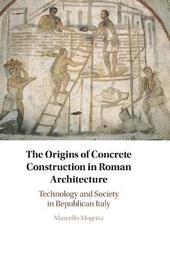
|
The Origins of Concrete Construction in Roman Architecture: Technology and Society in Republican Italy
Hardback
Main Details
| Title |
The Origins of Concrete Construction in Roman Architecture: Technology and Society in Republican Italy
|
| Authors and Contributors |
By (author) Marcello Mogetta
|
| Physical Properties |
| Format:Hardback | | Pages:350 | | Dimensions(mm): Height 254,Width 178 |
|
| Category/Genre | Ancient and classical art BCE to c 500 CE
History of architecture
Classical Greek and Roman archaeology |
|---|
| ISBN/Barcode |
9781108845687
|
| Classifications | Dewey:624.18340937 |
|---|
| Audience | | Professional & Vocational | |
|---|
| Illustrations |
Worked examples or Exercises
|
|
Publishing Details |
| Publisher |
Cambridge University Press
|
| Imprint |
Cambridge University Press
|
| Publication Date |
24 June 2021 |
| Publication Country |
United Kingdom
|
Description
In this study, Marcello Mogetta examines the origins and early dissemination of concrete technology in Roman Republican architecture. Framing the genesis of innovative building processes and techniques within the context of Rome's early expansion, he traces technological change in monumental construction in long-established urban centers and new Roman colonial cites founded in the 2nd century BCE in central Italy. Mogetta weaves together excavation data from both public monuments and private domestic architecture that have been previously studied in isolation. Highlighting the organization of the building industry, he also explores the political motivations and cultural aspirations of patrons of monumental architecture, reconstructing how they negotiated economic and logistical constraints by drawing from both local traditions and long-distance networks. By incorporating the available evidence into the development of concrete technology, Mogetta also demonstrates the contributions of anonymous builders and contractors, shining a light on their ability to exploit locally available resources.
Author Biography
Marcello Mogetta is a Mediterranean archaeologist whose research focuses on early Roman urbanism in Italy. He conducts primary fieldwork at the sites of Gabii (Gabii Project) and Pompeii (Venus Pompeiana Project), for which he has received multiple grants from the National Endowment for the Humanities, the Loeb Classical Library Foundation, the AIA, and the Social Sciences and Humanities Research Council. He coordinates the CaLC-Rome Project, an international collaboration that uses 3D modeling and surface analysis to the life cycle of ceramic vessels from the Esquiline necropolis in Rome. He is the editor of Elite Burial Practices and Processes of Urbanization at Gabii (JRA Suppl. 108, 2020), and co-editor of A Mid-Republican House from Gabii (2016) and Domitian's Rome and the Augustan Legacy (forthcoming).
|